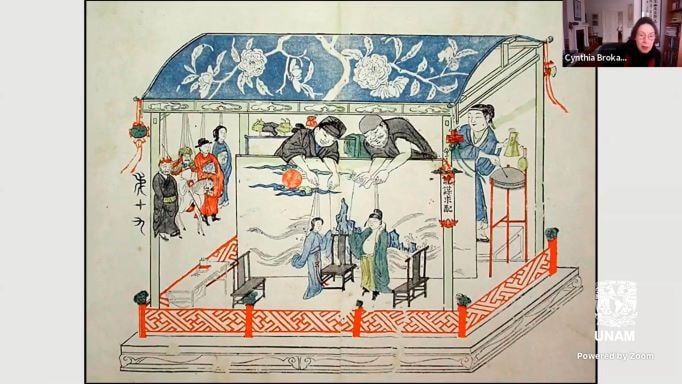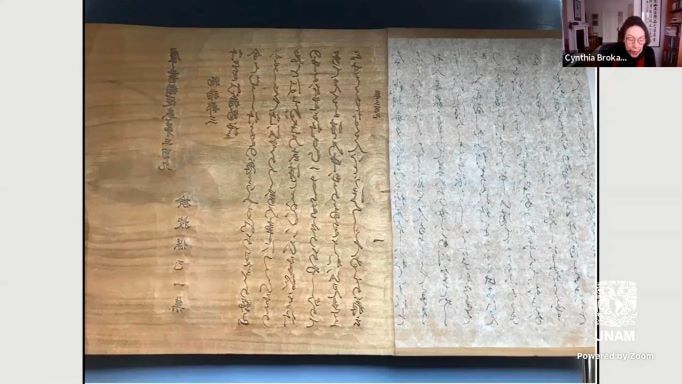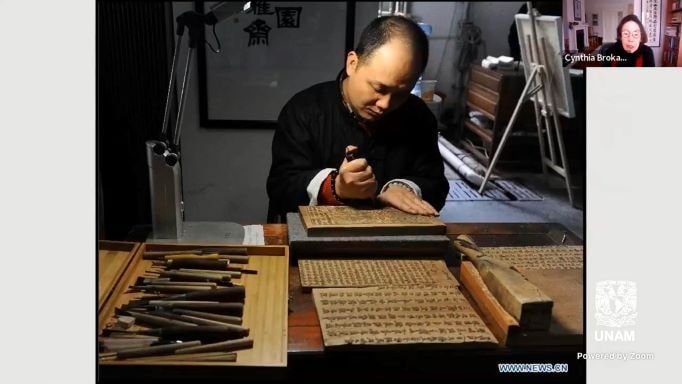Ancient Chinese printing techniques and aesthetics revisited
The printed book produced thousands of standardized classical texts. Because of their quality and detail, works with color illustrations circulated only among the Chinese elite. The number of Chinese characters amounts to more than 50,000, while the Gutenberg Bible used 290 types.

In addition to the invention of paper and gunpowder, China bequeathed to the world a printing tradition that endures to this day: teaching with texts that have official editorial care, as well as the protection of the book against the production of illegal copies, highlighted the researcher from Brown University, United States, Cynthia Brokaw.
With the talk "Xylographic printing and book culture in China before 1900", the historian and expert in Asian languages participated in the second cycle of conferences "A date with the National Library of Mexico: History of reading and books in the post-pandemic period. Reflections on an uncertain future", organized by the Institute of Bibliographic Research of the UNAM.
They developed a variety of techniques and the dominant one was woodblock printing, which used blocks of hardwoods, cut to the size of a folio sheet, with fine lettering crafted by a professional scribe, and carefully carved by craftsmen.
"A skilled printer could produce between 1,500 and 2,000 sheets per day. With a good block of wood, they could produce 15,000 impressions and, after some wear and tear, 10,000 more. Several blocks could be used for centuries and some of the editions of three dynasties survive. The reason why they could stop being used was because of poor maintenance, humidity, dryness, or the presence of insects," Brokaw said.
This technique lasted for 12 centuries from its invention (probably in the 7th century) until the introduction of Western lithography; although it was not the only method, as there is a record of a man who created a system that used movable type, such as Gutenberg's, whose use did not replace woodcut.
Prints with movable metal or tintype were developed in Korea in the 14th century, which was used in China until the 15th century, a technique adopted by extremely wealthy people.
The author of "The Ledgers of Merit and Demerit: Social Change and Moral Order in Late Imperial China" explained that woodcuts were better adapted as a reproduction technology due to the nature of the written language, as the number of Chinese characters can amount to around 50,000; that is, those recorded in the Kangxi Dictionary of 1710, a considerable amount if we consider that a literate person knows eight or nine thousand characters.
To measure the number of these, the Gutenberg Bible used 290 types, so it is not surprising that movable printing was little practiced in ancient China and woodcut printing was more prevalent.

For binding, the researcher explained that Chinese books can be bound in different ways, the oldest, the roll, is often used for religious texts. By the ninth and tenth centuries, the need for more works led to the use of a codex with thread or string, where the pages of the folio were folded in half, and the paper was inserted into holes drilled near the edge.
Using the example of "The Gynecology of Master Fu," Brokaw detailed some of the features standardized by Mandarin printers and now common to printed texts: a title page, the name of the authors and publisher, year or time of issue of the blocks, some form of advertising and, above all, a warning against unauthorized copying.
"Over time, the Chinese government and publishers recognized the value of printing as a means of disseminating important information and controlling or standardizing content. In the late 10th century, a system of examinations was the primary means of recruiting officials for government service, and since this involved mastery of the 13 Confucian classics and classic reference histories, it was necessary for the state to publish standardized versions of the classics for reproduction," the expert abounded.

Part of the beauty of some prints are the illustrations also made with assembled blocks that used to accompany engravings considered true pieces of art, such as the "Ten Bamboo Studio Manual of Calligraphy and Painting", from 1633, where it is possible to appreciate images of flowers, fruits, trees, and birds, among others.
"Some less famous, but more impressive illustrations are the color illustrations of Romance of the Western Wing, Collated by He Bi, by Min Qiji in 1640, which are not only beautiful but interpretative illustrations, showing drama, voyeurism, secrets, hiding places, and highlighting the elements of romantic drama, for example, a maid lurks behind a rock to watch her mistress, who, in turn, spies on the hero and plays the zither," she detailed.
The color prints were luxury items intended for an elite and probably never reached the conventional market, but served as a bargaining chip, a gift for small groups, Brokaw concluded.




